Development and Analysis of Mathematical Plunger Lift Models of the Low-Permeability Sulige Gas Field
Abstract
:1. Introduction
2. Development of Plunger Lift Mathematical Models
2.1. Uplink Phase
2.2. Continuous Phase
2.3. Downside Phase
2.4. Pressure Build-Up Phase
3. Calculation and Analysis
3.1. Operating Parameters of the Upstream and Renewal Phases of the Plunger
3.2. Operating Parameters of the Downward Phase of the Plunger
3.3. Operating Parameters of the Pressure Build-Up Phase
4. Production System and Production Parameter Design
5. Conclusions
Author Contributions
Funding
Data Availability Statement
Acknowledgments
Conflicts of Interest
References
- Xu, J.; Chen, Z.; Wu, K.; Li, R.; Liu, X.; Zhan, J. On the flow regime model for fast estimation of tight sandstone gas apparent permeability in high-pressure reservoirs. Energy Sources Part A Recovery Util. Environ. Eff. 2019, 41, 1–12. [Google Scholar] [CrossRef]
- Dongbo, H.; Guang, J.; Qianfeng, J.; Lihua, C.; Dewei, M.; Guoting, W.; Zhi, G.; Minhua, C.; Jiangchen, H. Differential development technological measures for high-water-cut tight sandstone gas reservoirs in western area of Sulige Gas Field. Nat. Gas Ind. 2022, 42, 73–82. [Google Scholar]
- Tugan, M.F. Deliquification techniques for conventional and unconventional gas wells: Review, field cases and lessons learned for mitigation of liquid loading. J. Nat. Gas Sci. Eng. 2020, 83, 103568. [Google Scholar] [CrossRef]
- Yu, R. A few points on the plunger lift of gas well deliquification. Drill. Prod. Technol. 1994, 17, 82–85. [Google Scholar]
- Foss, D.L.; Gaul, R.B. Plunger-life performance criteria with operating experience-ventura avenue field. In Drilling and Production Practice; American Petroleum Institute: Washington, DC, USA, 1965; pp. 124–130. [Google Scholar]
- Zhao, Q.; Zhang, L.; Liu, Z.; Wang, H.; Yao, J.; Zhang, X.; Yu, R.; Zhou, T.; Kang, L. A Big Data Method Based on Random BP Neural Network and Its Application for Analyzing Influencing Factors on Productivity of Shale Gas Wells. Energies 2022, 15, 2526. [Google Scholar] [CrossRef]
- He, S.; Wu, Z. Establishment of dynamic model for plunger gas lift. Acta Pet. Sin. 2005, 26, 88–92. [Google Scholar]
- He, S.; Wu, Z. Analysis the influence factors of plunger gas lift and optimizing design. Nat. Gas Ind. 2005, 25, 97–99+178. [Google Scholar]
- Wang, Z.; Sun, T.; Yang, Z.; Zhu, G.; Shi, H. Interactions between Two Deformable Droplets in Tandem Fixed in a Gas Flow Field of a Gas Well. Appl. Sci. 2021, 11, 11220. [Google Scholar] [CrossRef]
- Amani, P.; Rudolph, V.; Hurter, S.; Firouzi, M. Sustainable dewatering of unconventional gas wells using engineered multiphase flow dynamics. Fuel 2022, 324, 124675. [Google Scholar] [CrossRef]
- Hari, S.; Krishna, S.; Patel, M.; Bhatia, P.; Vij, R.K. Influence of wellhead pressure and water cut in the optimization of oil production from gas lifted wells. Pet. Res. 2022, 7, 253–262. [Google Scholar] [CrossRef]
- Sayman, O.; Jones, K.; Hale, R.; Pereyra, E.; Sarica, C. A field case study of plunger lift related tubing deformation. J. Nat. Gas Sci. Eng. 2022, 97, 104342. [Google Scholar] [CrossRef]
- Hashmi, G.M.; Hasan, A.R.; Kabir, C.S. Simplified modeling of plunger-lift assisted production in gas wells. J. Nat. Gas Sci. Eng. 2018, 52, 454–460. [Google Scholar] [CrossRef]
- Han, G.; Ma, G.; Gao, Y.; Zhang, H.; Ling, K. A new transient model to simulate and optimize liquid unloading with coiled tubing conveyed gas lift. J. Pet. Sci. Eng. 2021, 200, 108394. [Google Scholar] [CrossRef]
- Guerra, L.A.O.; Temer, B.O.; Loureiro, J.B.R.; Silva Freire, A.P. Experimental study of gas-lift systems with inclined gas jets. J. Pet. Sci. Eng. 2022, 216, 110749. [Google Scholar] [CrossRef]
- Akhiiartdinov, A.; Pereyra, E.; Sarica, C.; Severino, J. Data Analytics Application for Conventional Plunger Lift Modeling and Optimization. In Proceedings of the SPE Artificial Lift Conference and Exhibition—Americas, Virtual, 10–12 November 2020. [Google Scholar]
- Sayman, O.; Pereyra, E.; Sarica, C. Comprehensive Fall Velocity Study on Continuous Flow Plungers. SPE Prod. Oper. 2021, 36, 604–623. [Google Scholar] [CrossRef]
- Zhao, K.; Tian, W.; Li, X.; Bai, B. A physical model for liquid leakage flow rate during plunger lifting process in gas wells. J. Nat. Gas Sci. Eng. 2018, 49, 32–40. [Google Scholar] [CrossRef]
- Zhao, Q.; Zhu, J.; Cao, G.; Zhu, H.; Zhang, H.-Q. Transient Modeling of Plunger Lift for Gas Well Deliquification. SPE J. 2021, 26, 2928–2947. [Google Scholar] [CrossRef]
- Carpenter, C. Transient Plunger-Lift Model Improves Prediction of Liquid Unloading From Gas Wells. J. Pet. Technol. 2020, 72, 50–51. [Google Scholar] [CrossRef]
- Shi, H.; Liu, J.; Luo, W.; Ding, Y.; Li, R.; Liao, R. Study on Liquid Leakage Model of Rod Plunger Gas Lift. J. Xi’an Shiyou Univ. (Nat. Sci. Ed.) 2022, 37, 101–106+136. [Google Scholar] [CrossRef]
- Yin, B.; Pan, S.; Zhang, X.; Wang, Z.; Sun, B.; Liu, H.; Zhang, Q. Effect of Oil Viscosity on Flow Pattern Transition of Upward Gas-Oil Two-Phase Flow in Vertical Concentric Annulus. SPE J. 2022, 27, 3283–3296. [Google Scholar] [CrossRef]
- Zhao, K.; Mu, L.; Tian, W.; Bai, B. Transient Process of Gas Liquid Flow Sealing in Plunger Lift Method. J. Eng. Thermophys. 2020, 41, 1133–1138. [Google Scholar]
- Zhao, K.; Mu, L.; Tian, W.; Bai, B. Gas-liquid flow seal in the smooth annulus during plunger lifting process in gas wells. J. Nat. Gas Sci. Eng. 2021, 95, 104195. [Google Scholar] [CrossRef]
- Guo, W.; Zhang, X.; Kang, L.; Gao, J.; Liu, Y. Investigation of Flowback Behaviours in Hydraulically Fractured Shale Gas Well Based on Physical Driven Method. Energies 2022, 15, 325. [Google Scholar] [CrossRef]
- Huang, H.; Sun, Y.; Chang, X.; Wu, Z.; Li, M.; Qu, S. Experimental Investigation of Pore Characteristics and Permeability in Coal-Measure Sandstones in Jixi Basin, China. Energies 2022, 15, 5898. [Google Scholar] [CrossRef]
- Peng, C.; Feng, D.; Long, H. Assessing the Contribution of Natural Gas Exploitation to the Local Economic Growth in China. Energies 2022, 15, 5853. [Google Scholar] [CrossRef]
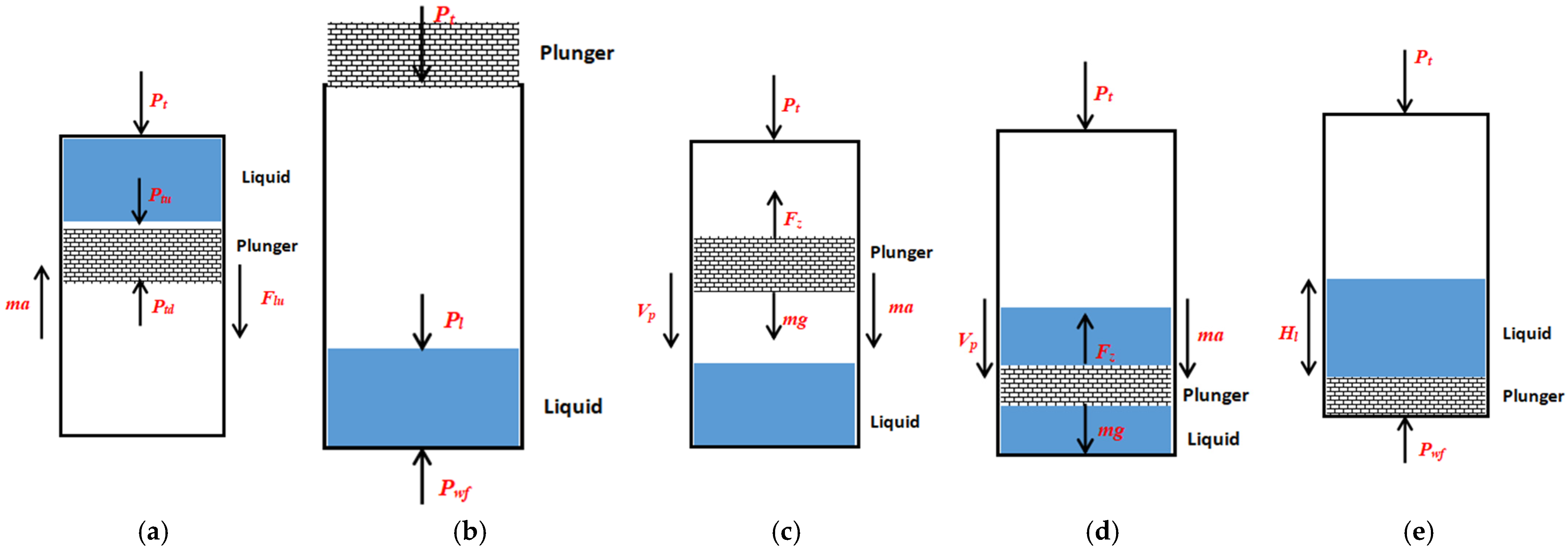



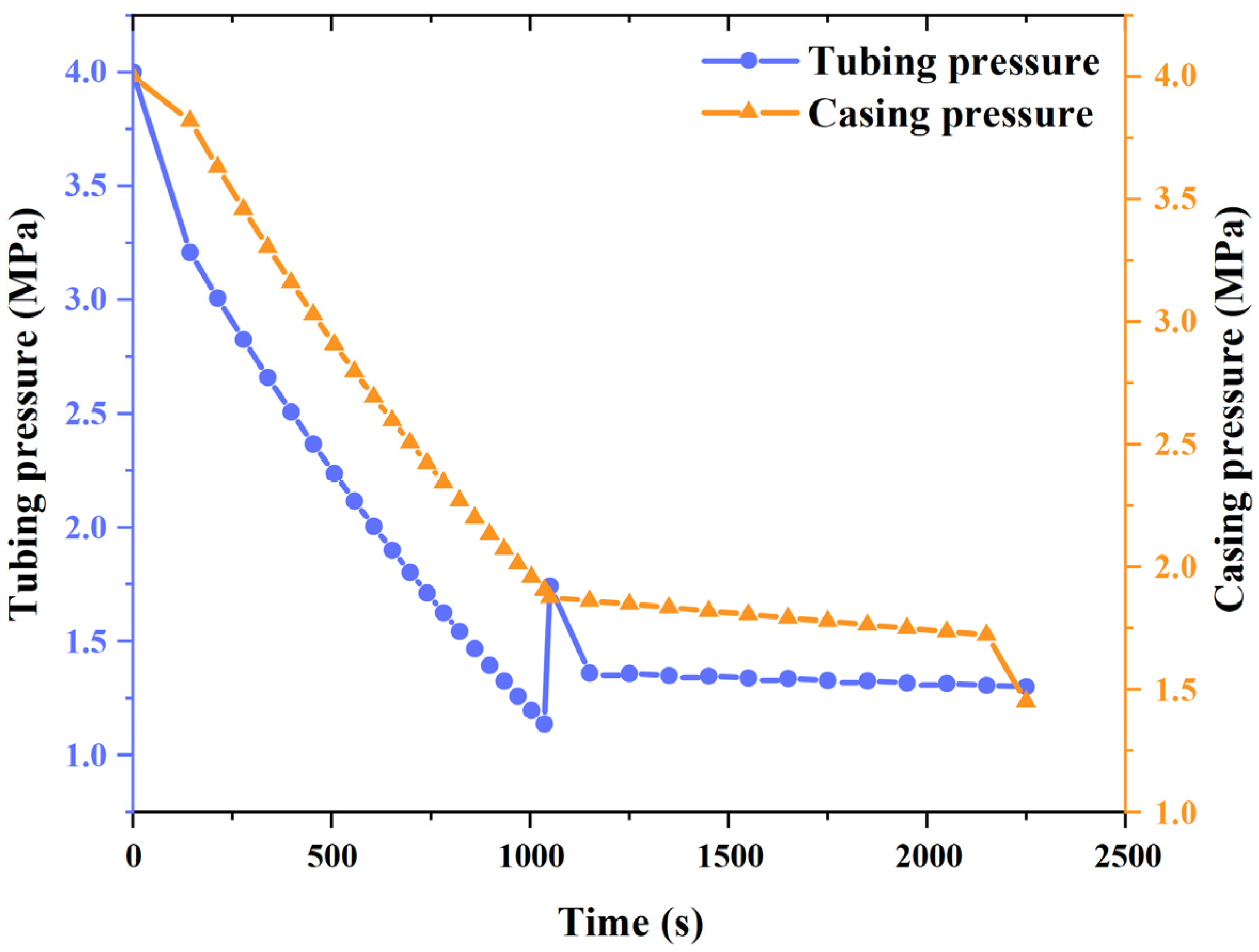
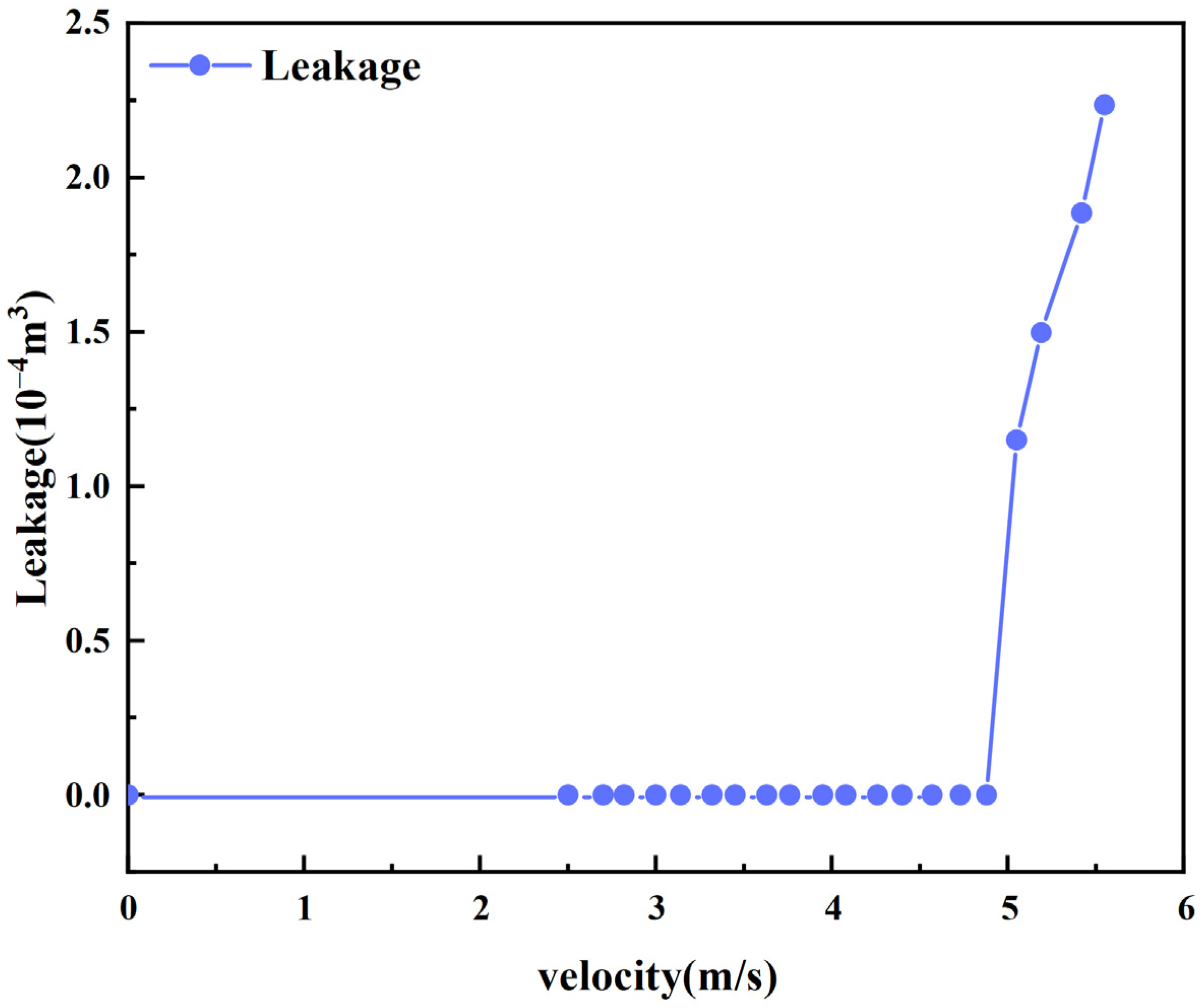
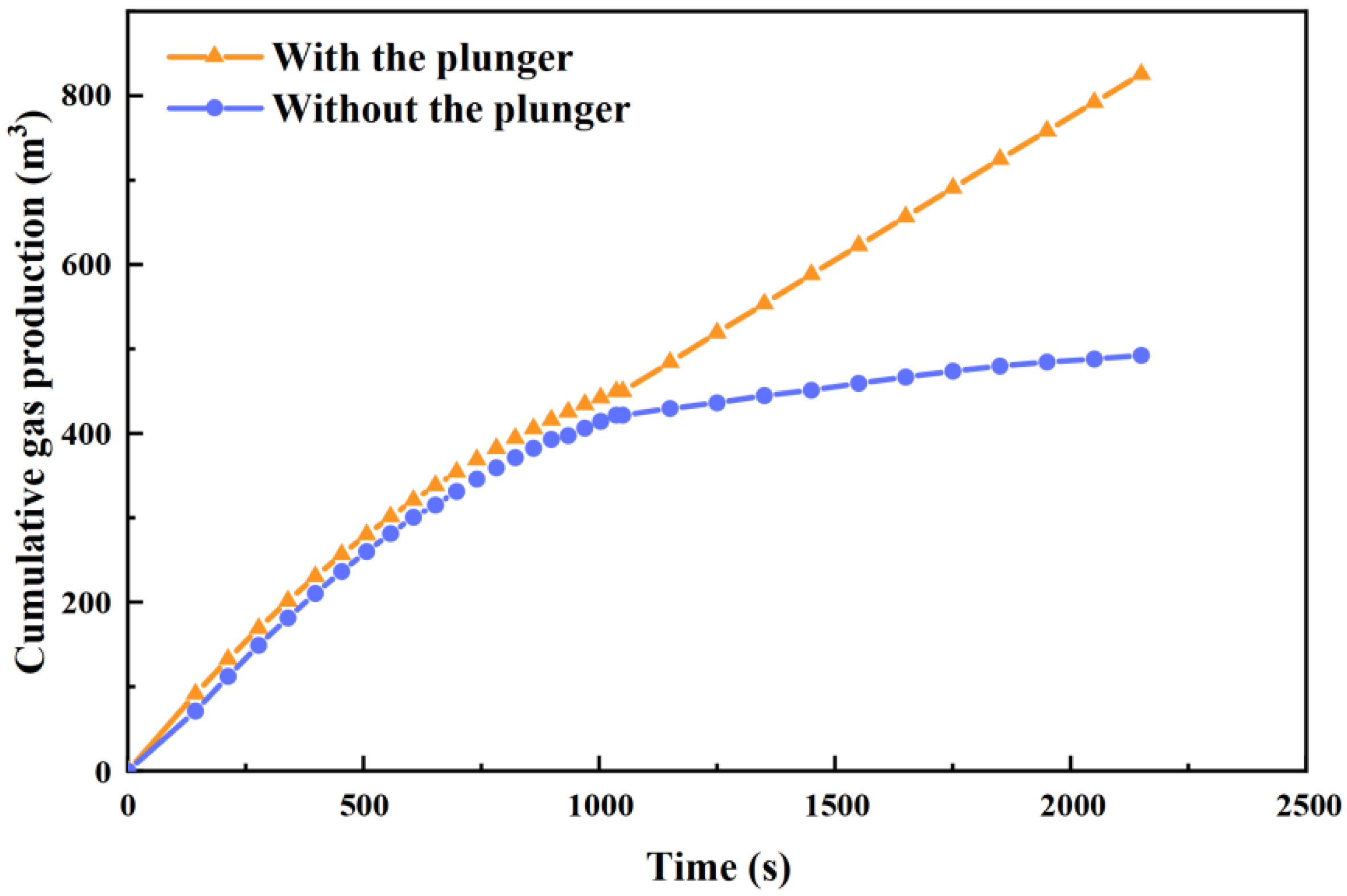
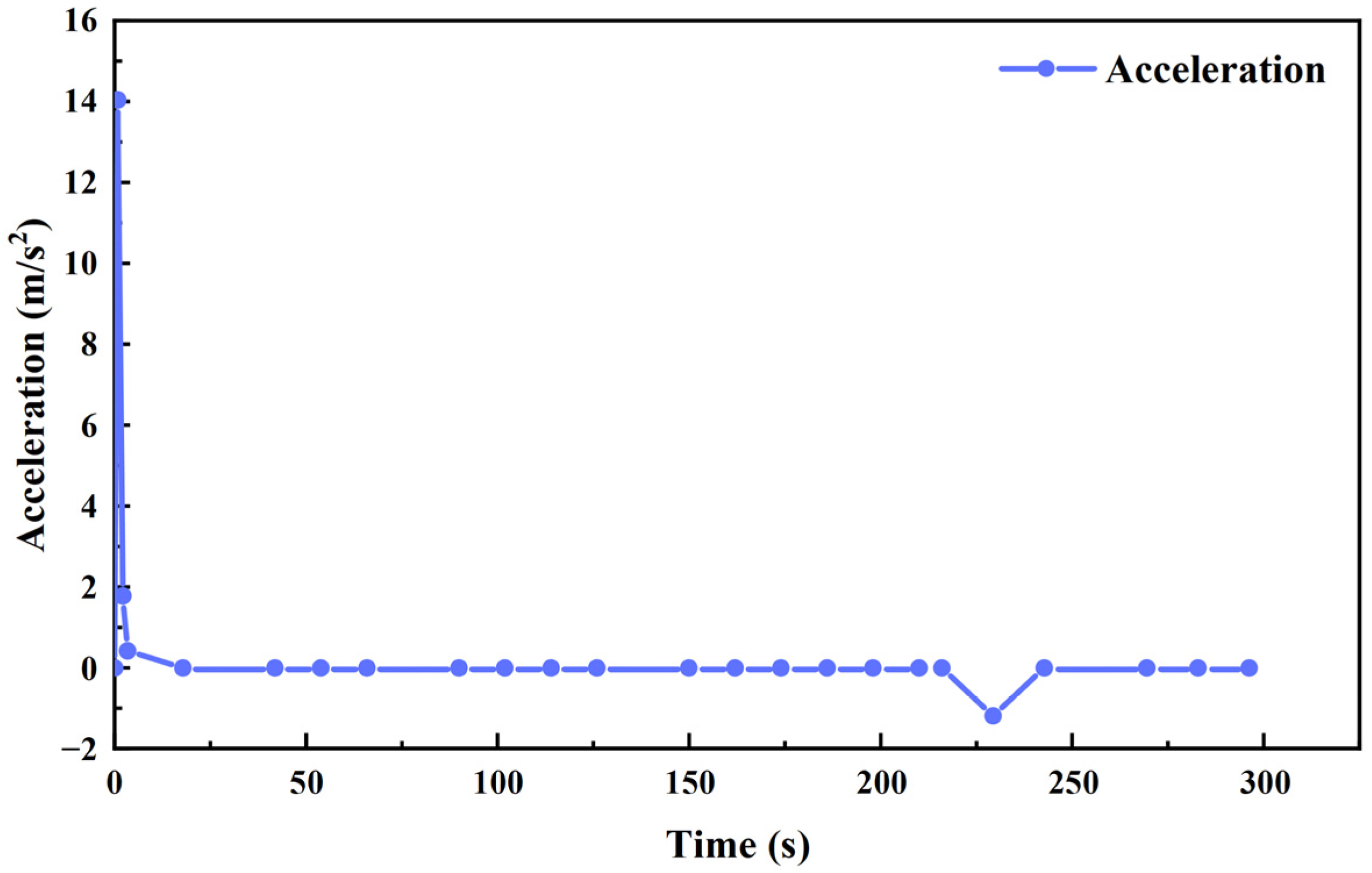


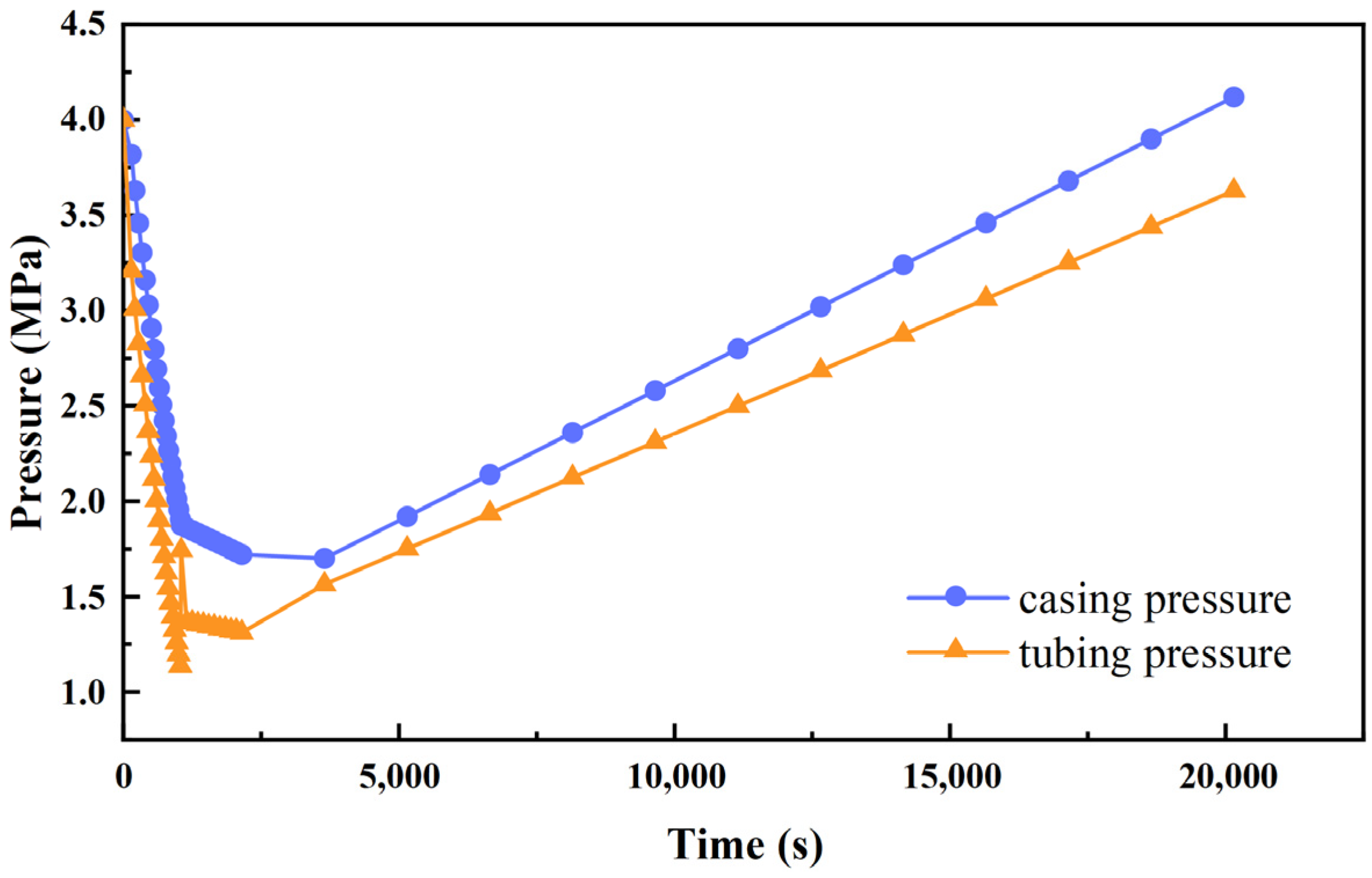
| Depth in the Middle of the Production Layer (m) | Depth of Oil Pipe Penetration (m) | External Diameter of Oil Pipe (mm) | Casing Inner Diameter (mm) | Well Bottom Temperature (K) | Tubing Pressure during Well Opening (MPa) | External Transmission Pressure (MPa) |
|---|---|---|---|---|---|---|
| 3720 | 3670 | 73 | 127 | 393 | 4 | 1 |
| Current Static Pressure (MPa) | Snap-In Depth (m) | Oil Pipe Inner Diameter (mm) | Wellhead Temperature (K) | Relative Density of Water (-) | Casing Pressure during Well Opening (MPa) | |
| 16 | 3660 | 62 | 313 | 1.053 | 4 | |
| Well Name | Casing Pressure (MPa) | Operation Cycle (min/c) | Periodicity Liquid Production Volume (m3/c) | Cyclic Gas Production (m3/c) | Daily Gas Production Capacity (m3/d) | Daily Cycle Number of Times (c/d) |
|---|---|---|---|---|---|---|
| X1 | 4 | 151 | 0.09362 | 1088 | 10,368.64 | 9.53 |
| X1 | 4 | 337 | 0.18724 | 823 | 3514.21 | 4.27 |
| X1 | 5 | 411 | 0.28086 | 1050 | 3675 | 3.5 |
| X1 | 6 | 527 | 0.3322 | 1394 | 3763.8 | 2.7 |
| X1 | 7 | 650 | 0.37488 | 1734 | 3814.8 | 2.2 |
| X2 | 4 | 151 | 0.2411 | 1827 | 15,164.1 | 8.3 |
| X2 | 4 | 337 | 0.5128 | 1463 | 5705.7 | 3.9 |
| X2 | 5 | 411 | 0.6252 | 1676 | 5363.2 | 3.2 |
| X2 | 6 | 527 | 0.8001 | 2269 | 5672.5 | 2.5 |
| X2 | 7 | 650 | 0.9091 | 2833 | 6232.6 | 2.2 |
| Well Name | Single Cycle Lifting Fluid Volume (m3/c) | Maximum Casing Pressure (MPa) | Average Casing Pressure (MPa) | Gas Demand (m3/c) | Gas-to-Liquid Ratio (m3/m3) | Number of Daily Cycles (c/d) | Daily Gas Production (m3/d) | Daily Liquid Production Volume (m3/d) | Oil Pipe down Depth (m) |
|---|---|---|---|---|---|---|---|---|---|
| X1 | 0.094 | 4 | 3.396 | 1088 | 4000 | 9.53 | 10,368.64 | 0.896 | 3670 |
| X2 | 0.241 | 4 | 3.192 | 1827 | 3500 | 8.3 | 15,164.1 | 2.001 | 3350 |
Disclaimer/Publisher’s Note: The statements, opinions and data contained in all publications are solely those of the individual author(s) and contributor(s) and not of MDPI and/or the editor(s). MDPI and/or the editor(s) disclaim responsibility for any injury to people or property resulting from any ideas, methods, instructions or products referred to in the content. |
© 2023 by the authors. Licensee MDPI, Basel, Switzerland. This article is an open access article distributed under the terms and conditions of the Creative Commons Attribution (CC BY) license (https://creativecommons.org/licenses/by/4.0/).
Share and Cite
Cai, W.; Zhang, H.; Huang, Z.; Mo, X.; Zhang, K.; Liu, S. Development and Analysis of Mathematical Plunger Lift Models of the Low-Permeability Sulige Gas Field. Energies 2023, 16, 1359. https://doi.org/10.3390/en16031359
Cai W, Zhang H, Huang Z, Mo X, Zhang K, Liu S. Development and Analysis of Mathematical Plunger Lift Models of the Low-Permeability Sulige Gas Field. Energies. 2023; 16(3):1359. https://doi.org/10.3390/en16031359
Chicago/Turabian StyleCai, Wenbin, Huiren Zhang, Zhimin Huang, Xiangyang Mo, Kang Zhang, and Shun Liu. 2023. "Development and Analysis of Mathematical Plunger Lift Models of the Low-Permeability Sulige Gas Field" Energies 16, no. 3: 1359. https://doi.org/10.3390/en16031359
APA StyleCai, W., Zhang, H., Huang, Z., Mo, X., Zhang, K., & Liu, S. (2023). Development and Analysis of Mathematical Plunger Lift Models of the Low-Permeability Sulige Gas Field. Energies, 16(3), 1359. https://doi.org/10.3390/en16031359





